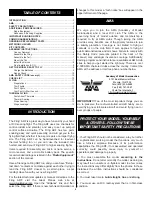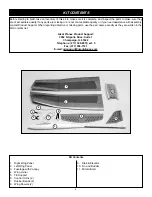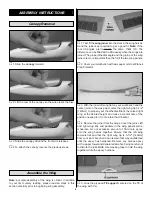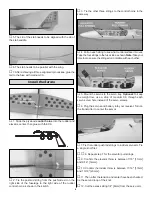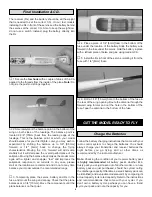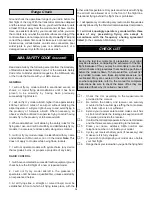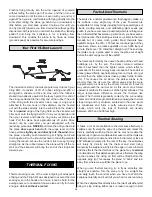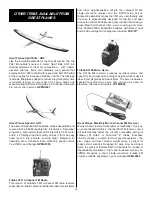
circling (especially in a contest where every second counts). Fly
straight ahead until you feel like you are in the strongest lift, fly
a couple of seconds farther (so your circle will be centered in
the strongest lift) and then start circling in a fairly tight but
smooth turn. When the sailplane is low the turns have to be
tighter to stay in the strongest lift. As the plane gains altitude, the
turns can be larger and flatter. The flatter the turn, the more
efficient the plane is flying, but don’t be afraid to really “crank” it
into a steep bank when you are low. If you see the plane falling
off on one side of the turn, move your circle over into the stronger
lift. Thermals move along with the wind so as you circle you will
be swept along with it. Be careful when thermaling, that you don’t
get so far downwind you can’t make it back to the field to land.
If the sailplane is flying along straight and all of a sudden
turns, let the plane continue to bank (you may have to give
it some rudder to keep it banking) until it has turned 270°
(3/4 of a full circle). Straighten out the bank and fly into
whatever turned the plane. If you encounter lift, and you
won’t every time, start circling just as you did when flying
directly into a thermal.
Thermals are generated all day long, but the strongest
thermals are produced when the sun is directly overhead.
10:00 am – 2:00 pm seems to be the best time to get those
“killer” thermals. Some of these thermals can be very large
and you may find it hard to get out of them. If you find
yourself getting too high, don’t dive the plane to get out of
the lift. Sailplanes are very efficient aircraft and they will
build up a lot of speed and could “blow up” in the rough air
of a thermal. The easiest way to lose altitude is to apply full
rudder and full up elevator. This will put the plane into a tight
spin that will not over stress the airframe but it will enable it
to lose altitude very quickly. This is especially helpful if the
sailplane gets sucked into a cloud or it gets too high to see.
The twirling action will give the sun a better chance of
flashing off of the wing and catching your attention. When
you are high enough and want to leave the thermal, add a
little down trim to pick up some speed and fly 90 degrees to
the direction of the wind. If you are not real high and want to
find another thermal, you may want to look upwind of the
last thermal. The same source that generated this thermal is
probably producing another. Just watch out for “sink” which
is often found behind and between thermals.
As you might expect, with all this air rising, there is also air
sinking. This air is the sailplane pilot’s nightmare that can
really make soaring challenging. “Sink” is usually not as
strong as the thermals in the same area, but it can be very
strong. Down drafts of many hundreds of feet per minute are
common on a good soaring day. These down drafts can
make a sailplane look like it is falling out of the air. Because
of this, it is important that you do not let the sailplane get too
far downwind.
When encountering sink, immediately turn and fly 90
degrees to the direction of the wind (towards you if
possible). Apply a little “down elevator” and pick up some
speed to get out of the sink as fast as possible. Every
second you stay in the sink is precious altitude lost.
Slope soaring is a type of flying that is very popular in hilly
regions and along the coasts. This type of soaring is
possible when the wind is blowing directly up a hill or cliff. As
the wind hits the slope it is forced up, producing lift which
can be utilized by real sailplanes, hang gliders, birds and
even model sailplanes. To be able to slope soar, you need a
slope with a smooth piece of land (or water) out in front of it
and a breeze blowing pretty close to straight up the slope.
The higher and steeper the hill or cliff the better. Also the
larger and smoother the land out in front the better. The air
flowing along hits the hill, is forced up and can generate a
very large area of lift. Behind the hill is a large area of
turbulent air that can be very dangerous to try to fly in. The
faster the wind is blowing, the stronger the lift and
turbulence will be. To fly off a slope, stand near the edge and
throw the sailplane (nose down) into the wind. As the
sailplane flies out into the “band” of lift it will begin to gain
altitude. Turn and fly parallel to the slope and make all of
your turns into the wind (especially when you are close to
the slope). You will be surprised at the altitude you can gain
just from slope lift. Thermals will often be “popped loose” by
these slopes. If you catch a thermal and follow it downwind,
be very careful to stay high enough to make it back to the
slope without flying through the turbulent air behind the
slope. If you don’t have enough altitude you may want to
land a good distance behind the slope if possible to avoid
this turbulent air.
Landings can be very tricky on some slopes. On gentle slopes
you can often fly very close to the top of the slope and “slide”
into the top of the slope without encountering any turbulent air.
On steeper slopes you may have to be a little more aggressive
to get the plane out of the lift. In any case it is a good idea to plan
your landing before launching your plane.
Have a ball! Remember to always stay in control and fly
in a safe manner.
GOOD LUCK AND GREAT FLYING!
Make a copy of this identification tag and put it on or
inside your model.
Slope Landings
Slope Soaring
13
Summary of Contents for FLING
Page 15: ...15 FLYING NOTES...


